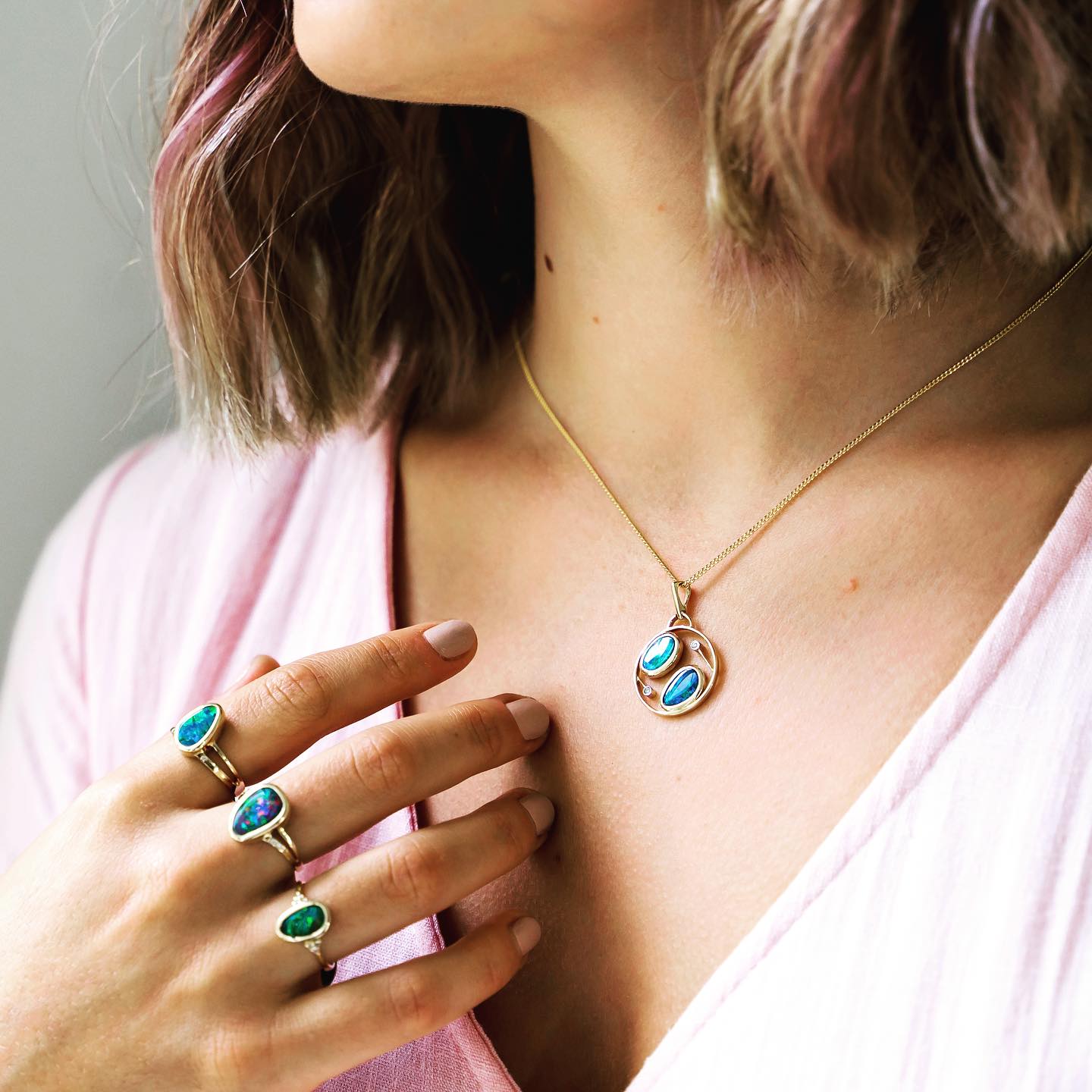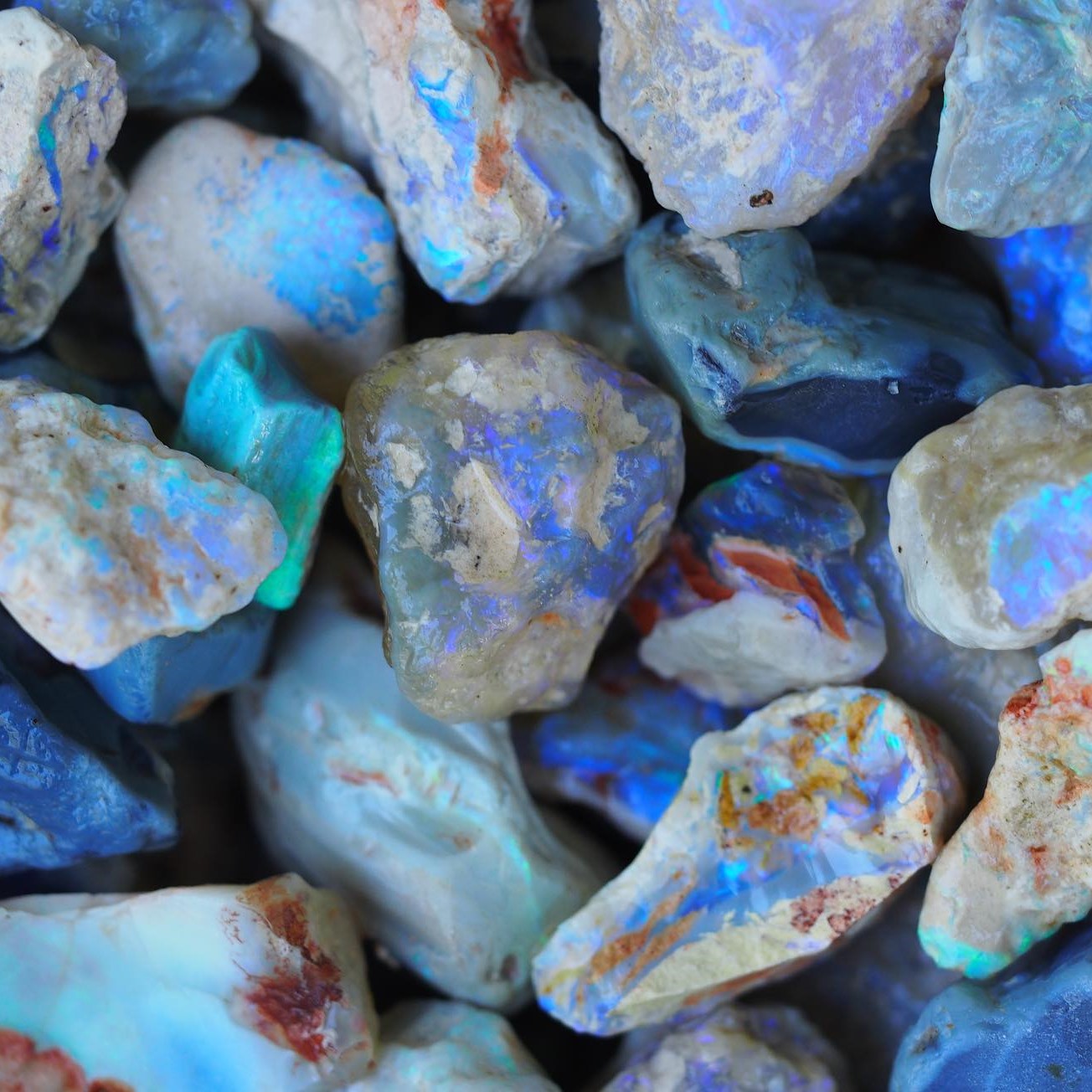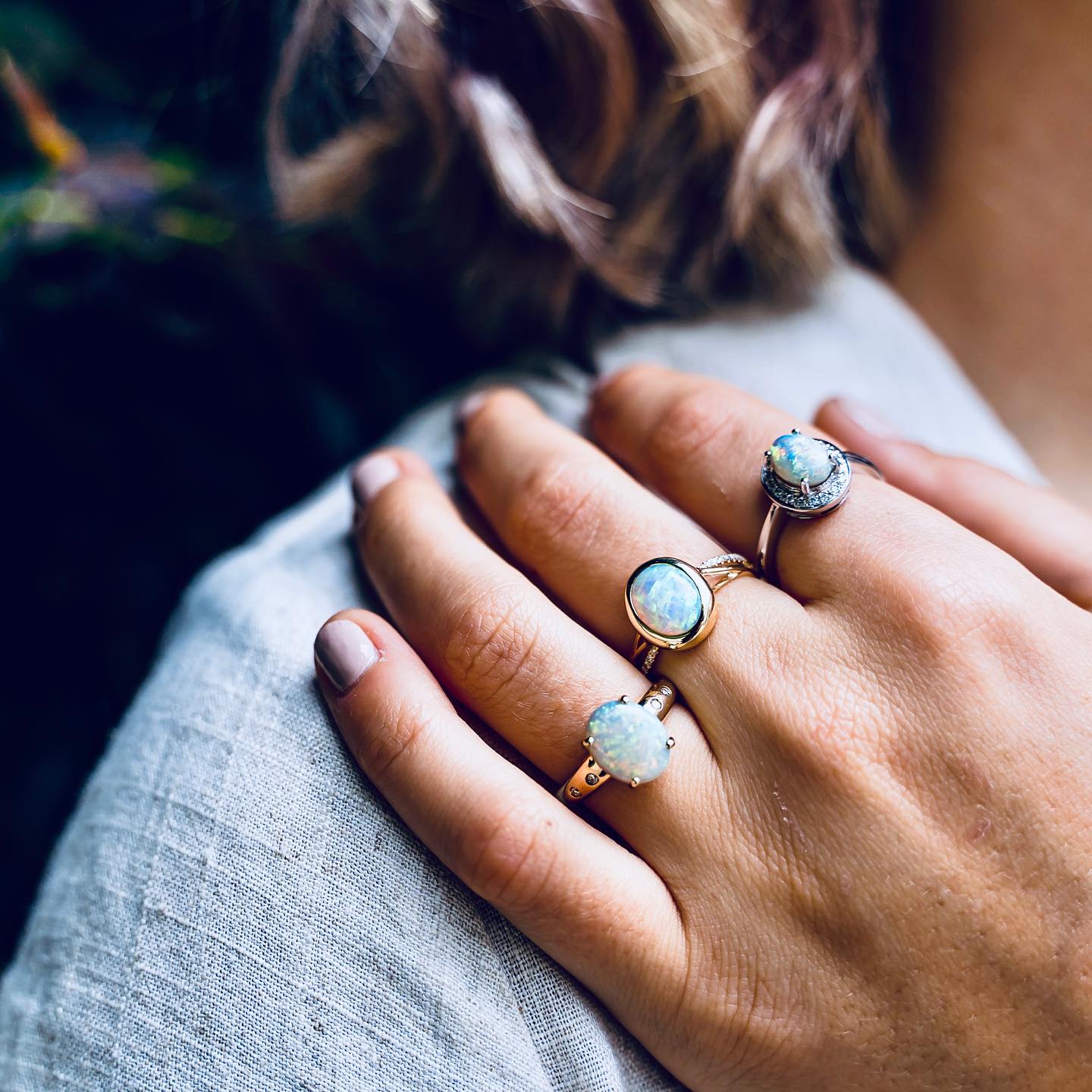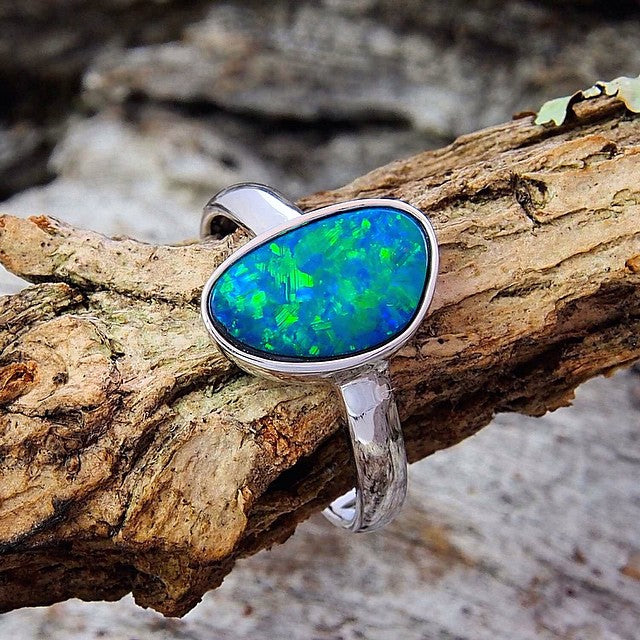Article: Opal Mining in Australia: Where Opals Are Born
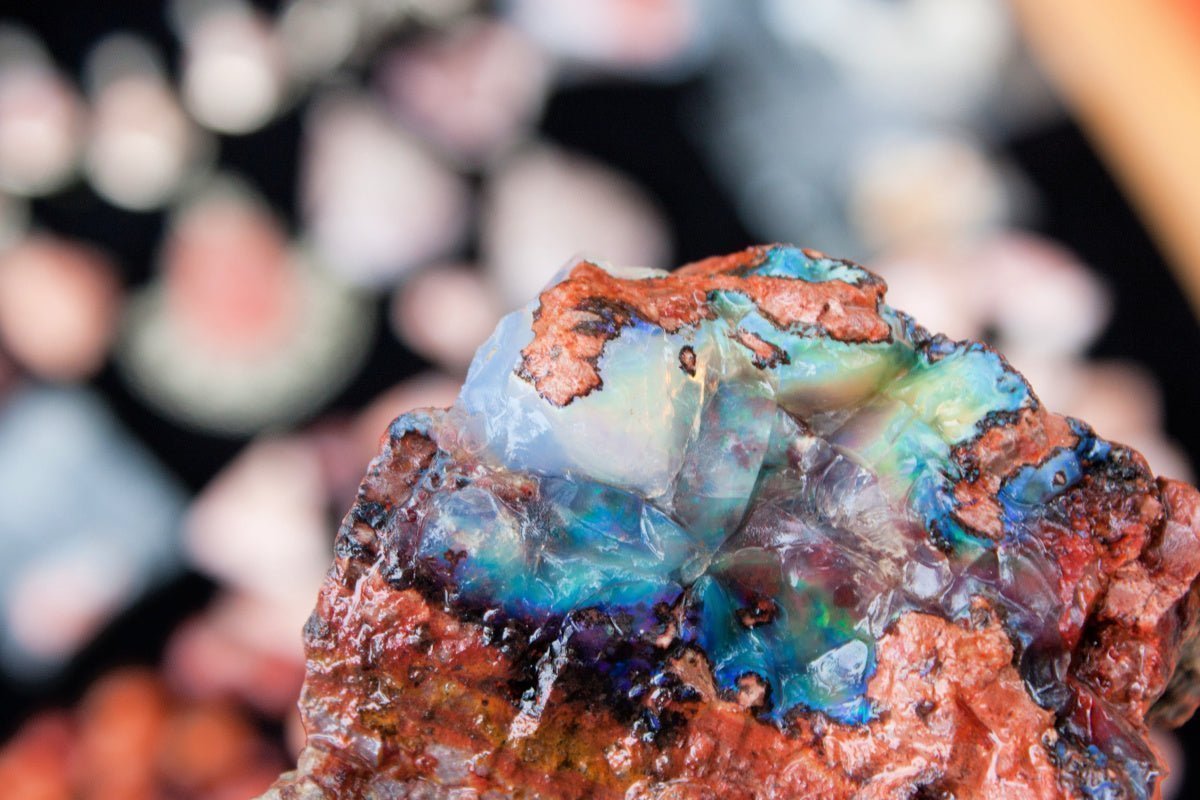
Opal Mining in Australia: Where Opals Are Born
Australia produces over 95% of the world’s commercial, gem-quality opals—a gemstone whose famous 'play-of-colour' has enchanted collectors, jewellery lovers and miners alike for generations. But what lies beneath this shimmering, polished beauty is a rugged, enduring industry built on exploration, dedication and discovery over more than 100 years.
From the remote desert fields of Coober Pedy to the black opal capital of Lightning Ridge and the rugged ironstone boulders of Queensland, opal mining in Australia is a story of grit, discovery and dazzling beauty. At Black Star Opal, our own journey into this world began in 1969, when our family first started mining for opals in the legendary Lightning Ridge fields—an experience that shaped our deep connection to this rare and captivating gemstone.
So let’s take a deep dive into where and how opals are mined across the country—and why Australian opal remains the most prized in the world.
What Is Opal Mining?
Opal mining is the process of extracting precious opal from underground seams in sedimentary rock. Unlike traditional hard rock mining, opal is often found in narrow, unpredictable pockets. This makes it labour-intensive and reliant on the miner's intuition, experience, and determination.
Australian opal fields are known for their harsh conditions, requiring both rugged machinery and enduring spirit. Some of the most valuable opals in the world have been uncovered with little more than a pick, shovel and a dream. If you want to learn more about the unique qualities that make these opals so prized, check out our guide to What Is Opal?, where we explore the science and beauty behind this gemstone.
Where is opal mined in Australia?
Opal is mined across several regions of Australia, including Lightning Ridge in New South Wales, Coober Pedy and Andamooka in South Australia, White Cliffs in NSW, and boulder opal fields in Queensland towns like Winton and Quilpie. Each field produces distinct opal types, from black to white and boulder opal.
Major Opal Mining Regions in Australia
1. Lightning Ridge (NSW)
Renowned for producing the world's rarest and most valuable opal: the black opal. Lightning Ridge is a small outback town where our family story begins, and where many European migrants came in search of opportunity during the 1960s and '70s.
-
Opal Type: Black Opal (dark body tone with brilliant play-of-colour)
-
Mining Style: Underground shaft mining
Mining in and around 'The Ridge' is typically done in underground shafts, where miners descend via ladders or winches to reach opal-bearing levels, sometimes 20 metres or more below ground. Mining operations on these opal fields are often family-run or worked by independent miners, keeping the tradition of small-scale opal mining alive. Life is as colourful as the stones it produces, with stories of million-dollar finds and decades-long dry spells woven into its dusty red earth.
What makes Lightning Ridge opal unique?
Lightning Ridge is the only place in the world where true black opal is found. Its dark body tone enhances the play-of-colour, making it one of the most valuable opals on Earth.

2. White Cliffs, New South Wales
White Cliffs is the site of Australia’s first commercial opal discovery in the late 1800s. This remote New South Wales settlement is renowned for producing brilliant white opals and the incredibly rare opal 'pineapples'—a spiky, spherical formation created when opal replaces gypsum crystals. This location is also known for producing fine-quality opalised fossils.
Opal mining in White Cliffs is often carried out by locals living in dugouts—underground homes built to escape the region’s blistering summer heat. The mines themselves are shallow compared to other fields, but just as rich in history and character. Life in White Cliffs is quiet and rugged, but full of charm, with a strong community of miners, artists and adventurers keeping the legacy of Australia’s first opal rush alive.
3. Coober Pedy (SA)
Known as the 'opal capital of the world', Coober Pedy is famous for white and crystal opal and its underground homes (dugouts) where miners escape the extreme desert heat.
-
Opal Type: White Opal (milky body tone with pastel colours) and Crystal Opal (transparent body tone with bright colours)
-
Mining Style: Open cut and shaft mining
Coober Pedy’s opal fields stretch across a vast expanse of arid desert, and due to the harsh climate, many residents live underground to escape the heat. Mining is mostly open-cut or by using bulldozers and tunnelling machines to extract the opal-bearing clay layers. This town is not just a mining hub—it’s a community where every local has a tale of 'opal fever' and the thrill of striking colour in stone.
3. Andamooka (SA)
Produces opals with warm tones and intricate patterns. Andamooka stones are often treated with sugar and acid solutions or polished to enhance their colour.
-
Opal Type: Matrix and White Opal
Mining in Andamooka is a mix of hand-dug shafts and small-scale operations, with much of the work still done by passionate individual miners and families. The harsh, arid landscape adds to the frontier feel of the town, where the reward of discovering a beautiful gem keeps the opal spirit alive. Known for its welcoming atmosphere and time-worn charm, Andamooka continues to attract collectors and fossickers alike, eager to uncover a piece of Australia’s opal mining heritage.
5. Mintabie, South Australia
Tucked away in the remote north-west of South Australia, Mintabie was once a thriving opal mining settlement known for producing high-quality black opal and dark opal—gems usually more associated with Lightning Ridge. The opals found here are distinguished by their strong play-of-colour and darker body tone, making them particularly desirable among collectors and jewellers seeking bold, vivid stones.
Mining in Mintabie took place primarily through open-cut and underground shaft methods. At its peak in the 1980s, Mintabie was home to hundreds of miners and their families, creating a unique and resilient outback community. However, in 2018, the South Australian government made the decision to close the township due to concerns around illegal activity and land rights. While limited mining operations continue under strict regulation, the town’s future remains uncertain.
6. Queensland Boulder Fields
These expansive fields are home to the unique and durable boulder opal, which forms in ironstone boulders particularly around towns like Winton, Quilpie, Yowah and Koroit.
-
Opal Type: Boulder Opal (ironstone matrix with vivid colours)
-
Mining Style: Open cut, shallow depth
Unlike other fields, Queensland's opal mining is done in 'open cut' or 'nobby' fields where the opal is mined as part of boulder-sized chunks. Extraction is followed by a slow, careful cutting process that reveals the gem inside. Queensland boulder opal is praised for its durability, vibrant colours and earthy, natural appearance. Many pieces are cut freeform to showcase the unique patterns within the ironstone.
Australian Opal Rock Formations
In Lightning Ridge, opal is typically found in two main formations: seam opal and nobby opal. Seam opal forms in flat, horizontal layers within sandstone or claystone, often producing large, thin pieces with brilliant colour bars. Nobby opal, on the other hand, forms as rounded, knobby lumps and can contain vibrant gem-quality opal inside a sandy outer shell. These nodules are unique to Lightning Ridge and are highly prized when found with bright colour and clarity.

In Coober Pedy and Andamooka, most opal forms as seam opal within soft, white sandstone or clay layers, while in White Cliffs, opal occurs in narrow seams and nodules, often deep within white sandstone formations.
In Queensland, the main formation is boulder opal, which forms in thin veins or patches within large ironstone boulders. The opal is permanently attached to its ironstone host rock, giving boulder opal its signature earthy appearance and making it one of the most durable types of opal.
What are the main types of opal mined in Australia?
Australia produces black opal, white opal, crystal opal, matrix opal, and boulder opal. Each variety has unique colour play and geological formations, with black opal from Lightning Ridge being the rarest and most valuable.
The Opal Mining Process
Opal mining is a physically demanding and often unpredictable process. It can involve months or even years of digging without finding a single gem—but the rewards can be extraordinary for those with persistence, skill and a little luck.
Registering a Claim
Before any digging begins, miners must register a mining claim or lease to gain the legal right to search for opal on a specific piece of land—each Australian opal field has its own local regulations and licensing authorities. The process typically involves submitting an application, paying a fee, and clearly marking the boundaries of the claim. In Lightning Ridge, miners must also complete an Opal Mining Safety Workshop and an Environmental Awareness Course. Registered claims not only manage land use but protect miners’ rights, with ongoing requirements such as permit renewals and compliance with environmental and rehabilitation guidelines, particularly in more regulated areas like Queensland.
Drilling and Blowing
When a potential opal level is identified, drill rigs are brought in to take core samples. If traces of opal colour appear in the drill cuttings, it's a sign that further exploration is worthwhile. Miners then use a blower, a giant vacuum system, to remove overburden (loose rock and dirt) from shafts or trenches. This allows for faster, cleaner access to underground tunnels or open-cut pits.

Open-Cut Mining
In certain opal fields—particularly in Queensland—open-cut mining is the preferred method. This approach involves using heavy machinery such as bulldozers and excavators to remove overburden and expose opal-bearing rock close to the surface. Unlike traditional underground mining, open-cut techniques allow miners to follow opal seams horizontally and extract larger volumes of material at once.
Fields like Winton, Quilpie, and Koroit are renowned for this method, as boulder opal forms in ironstone nodules within shallow, horizontal layers. Although expensive, it can yield substantial returns when opal colour is present. While Lightning Ridge is primarily known for deep shaft mining, open-cut techniques are occasionally used there too—particularly for shallow pockets—but are less common in New South Wales due to stricter legal and land access regulations.
Tunnelling and Shaft Mining
In Lightning Ridge and Coober Pedy, shaft mining is the most common method. Miners sink vertical shafts—often over 20 metres deep—then tunnel horizontally at opal level in ‘drives’. Though slower and more labour-intensive than open-cut mining, it’s ideal for tracing narrow opal seams through sandstone or claystone. Small teams or solo miners use jackhammers, picks, and compact tunnelling machines to extract rock, inspecting each piece for hints of opal. The work is unpredictable—entire drives can come up empty—but one lucky strike can uncover a million-dollar gem hidden deep underground.

From Dirt To Treasure
Once the hard digging is done, the real treasure hunt begins because opals don’t always reveal themselves easily. The rock and dirt extracted from shafts or open cuts, often called 'opal dirt', must be carefully processed to separate worthless material from the prized opal hidden within.
Washing and Tailing Out
After extraction, opal-bearing dirt is transported—by wheelbarrow, truck, or bucket—to a wash area. There, it’s placed in agitators or makeshift wash tubs, where water helps dissolve clay and loosen debris. The material is tumbled or stirred until it breaks down enough for inspection.
Miners then 'tail out' the contents, spreading the washed gravel onto a flat surface under sunlight or fluorescent lights. With eyes trained for colour, they scan for the telltale glint of opal. This step is especially vital in fields like Coober Pedy, where soft clay and sandstone often hide precious gems just beneath the surface.
Separating Opal from Host Rock
Sometimes, especially in boulder opal fields like those in Queensland, the opal is embedded in ironstone boulders. These are not washed in the same way as softer opal dirt, but instead chipped, sawn or ground to expose veins and patches of opal within. This method requires a careful hand and a sharp eye to avoid damaging valuable stone. In other areas like Lightning Ridge or Andamooka, opal-bearing sandstone is usually softer and can be carefully examined once washed and broken down, making it easier to spot opal in host rock fragments.
Noodling: One Miner’s Trash...
Even after a tail out, not all opal is found. That’s where noodling comes in. Noodling is the process of re-sifting through discarded mine tailings, often by hand or with simple sieves and UV lamps at night. It’s not uncommon for miners or fossickers to find missed pieces of opal left behind in waste heaps, especially under changing light conditions. In places like Lightning RIdge, Coober Pedy and White Cliffs, public noodling areas have even been set up for tourists and hopefuls to try their luck. It’s a great example of how opal fields keep giving — and why attention to detail is crucial.

Sorting and Grading: Identifying Precious Finds
Once the opal-bearing dirt has been washed and 'tailed out', the next crucial step is sorting and grading the recovered material. Miners carefully sift through the cleaned stones to identify any promising opal specimens. This process can be painstaking—many stones will appear dull or ordinary at first glance, only revealing flashes of colour when viewed under the right lighting or from a specific angle.
Rough opals are examined for signs of 'play-of-colour', clarity and potential size. Specimens are separated into categories such as common potch (non-gem opal), potch with colour, and precious opal. In places like Lightning Ridge, this includes determining whether the opal is a 'nobby' (rounded nodule formation) or a seam opal (formed in horizontal veins). Once promising opals are identified and sorted, they’re ready for the next exciting step—cutting and polishing, where the gem’s full beauty is revealed.
Cutting and Polishing Opal
Once examined, rough opal is carefully cleaned and ready for cutting. Using diamond saws and grinding wheels, opal cutters shape the stone to preserve as much colour and carat weight as possible while removing flaws or potch. Opals are typically cut into cabochons—smooth, domed shapes that showcase the stone’s play-of-colour. Some are left in their natural freeform shapes, especially Queensland boulder opals, which often retain part of their host rock to highlight contrast and texture. Polishing is done with fine abrasives and oxides until the opal gleams.
Ethics and Sustainability of Australian Opal Mining
Australia’s opal industry is one of the most ethical and sustainable in the world. Unlike many gemstones mined under questionable conditions overseas, Australian opals are extracted under strict regulations, with licenses, environmental safeguards, and fair labour practices in place.
Small-scale operations: Most opal miners are individuals or families, not large corporations.
Environmental care: Miners are required to backfill shafts and rehabilitate land after use.
Local impact: Opal mining supports remote Australian communities with jobs and tourism.
Rehabilitating Opal Mining Claims
When an opal claim is no longer productive or a miner decides to stop work, the land must be rehabilitated—restored as closely as possible to its original state. This is a legal requirement in most Australian opal fields and plays a vital role in protecting the fragile outback environment. Rehabilitation typically involves backfilling shafts, pits, and trenches to prevent accidents, reshaping disturbed ground to match the natural terrain, and reapplying topsoil and native seed to encourage the return of local vegetation.
In states like Queensland and New South Wales, government agencies such as the Department of Resources or Department of Planning and Environment may inspect the site to ensure environmental standards are met. Miners lodge a bond when registering a claim, which can be used to fund rehabilitation if needed. Many miners take pride in caring for the land—understanding that responsible practices not only support the sustainability of opal mining, but also preserve the beauty and integrity of the country that once hid such dazzling treasures beneath its surface.

Our Family's Opal Mining Legacy
Our founder, Rade Deskoski, began his opal mining journey at Lightning Ridge in 1969, part of a pioneering wave of European migrants chasing fortune in the Australian outback. He mined black opal in many locations around the town, including lucrative fields like Coocoran, Nobbys and the Three Mile, all producing much sought after and rare black opal 'nobbies'.
In the 1980s, Rade was instrumental in expanding the international reach of Lightning Ridge opals, travelling to Japan and the United States to introduce black opal to global markets. His passion, resilience and strong ties to Australia’s opal mining community laid the foundation for what would later become our retail shop The Opal Centre and our online store Black Star Opal.
Today, we remain deeply connected to our network of trusted opal miners and cutters, honouring our roots while bringing these magnificent stones to the world.
The Future of Opal Mining
Opal mining has become more competitive and high-tech in recent years, but the heart of the industry remains in hands-on exploration and a passion for the stone. While big opal finds still make headlines, most opals on the market come from patient, persistent effort. As environmental considerations increase and known fields become harder to mine, demand is expected to outpace supply—making high-quality Australian opals even more valuable and a long-term investment.
Opal Mining Frequently Asked Questions
1. What is the history of opal mining in Australia?
Opal was first discovered in the 1800s, but mining boomed in the early 20th century. Towns like Lightning Ridge and Coober Pedy grew rapidly as miners flocked to uncover these vibrant stones.
2. Can I visit an opal mine in Australia?
Yes! Many mines in Lightning Ridge and Coober Pedy offer guided tours where you can explore underground shafts and learn about the mining process firsthand.
3. What makes Lightning Ridge opal unique?
Lightning Ridge is the only place in the world where true black opal is found. Its dark body tone intensifies the play-of-colour, making it one of the most sought-after gems.
4. Is opal mining dangerous?
While not as deep as some other types of mining, opal mining can still be hazardous due to narrow tunnels, dust, and equipment. Most miners work in small teams and follow strict safety practices.
5. How do I know if my opal is Australian?
Look for signs such as certification, reputable sellers, and tell-tale characteristics like body tone, colour play, and origin story. Our opals are always 100% Australian and ethically sourced.
6. How is opal mining different from other types of gemstone mining?
Mining opal is often more artisanal and small-scale than other gemstone operations. Many miners work independently or in small teams using hand tools or light machinery. Unlike large open-pit or corporate-run mines, most opal fields in Australia are made up of family-run claims and fossickers.
7. What tools are used in opal mining?
Tools range from simple picks, shovels and hand sieves to more advanced equipment like jackhammers, tunnelling machines (called 'diggers') and blowers (large vacuum systems). In underground mines like Lightning Ridge or Coober Pedy, ladders, winches and small mining hoists are also commonly used.
8. Can anyone start opal mining in Australia?
Yes, but you need a mining permit or claim, depending on the state or territory. Regulations vary, and you'll typically need to register, pay a fee and follow safety and environmental guidelines. Many people start with 'fossicking'—recreational searching with hand tools—which is allowed in designated areas without a full permit.
9. What is a 'blow-in' in opal mining communities?
A 'blow-in' refers to a newcomer who arrives at an opal field hoping to make a quick fortune. While some strike it lucky, most learn that opal mining is tough, uncertain, and often financially unpredictable.
10. How do miners know where to dig for opals?
Opal is typically found in specific geological conditions, such as claystone or sandstone layers within ancient seabeds. Miners look for indicators like 'opal dirt', colouration or geological fault lines. However, it's largely speculative—many miners rely on experience, instinct, and a bit of luck.
Final Thoughts: The Magic Beneath the Earth
Opal mining is about more than unearthing beautiful gemstones—it’s about storytelling, history, and discovery. Every stone carries a legacy of land, light, and human endeavour. And as long as people continue to fall in love with opal’s mysterious beauty, the mines of Australia will remain a place of wonder.
Whether you’re an avid collector or searching for a meaningful gift, understanding the story behind Australian opal mining enriches the experience of owning these remarkable gems. Explore our full opal jewellery collection to find rings, pendants, earrings, and more—each piece a testament to the unique beauty and history of Australia’s opal mines.
About the Author
Growing up on the opal fields of Lightning Ridge and working in her family’s gemstone and jewellery business for much of her life, Black Star Opal founder Olivia Deskoski brings deep, first-hand knowledge and rare expertise to Australia’s opal industry. Her qualifications include gemmology and diamond technology studies with the Gemmological Association of Australia, a Master’s in Journalism, and extensive experience in e-commerce and marketing communications. In 2015, Olivia created the world’s first opal-themed light installation for Vivid Sydney and has helped raise $1 million for the new Australian Opal Centre at Lightning Ridge.


